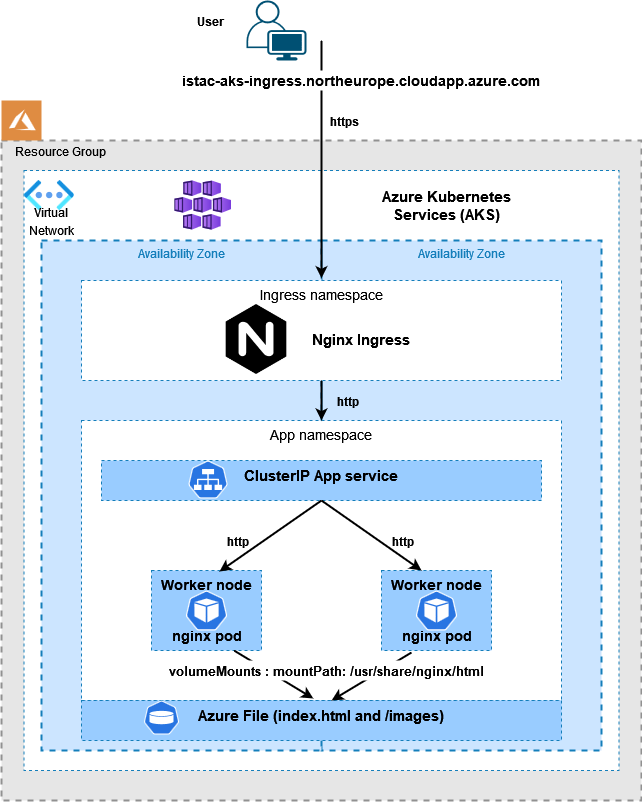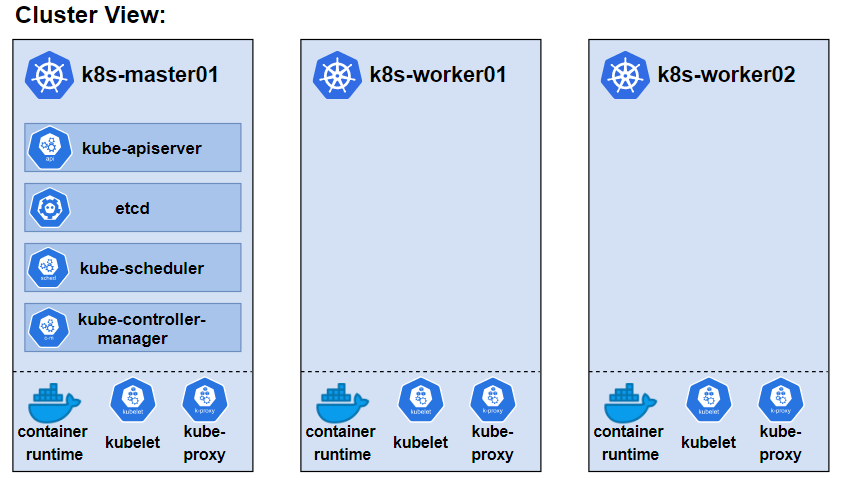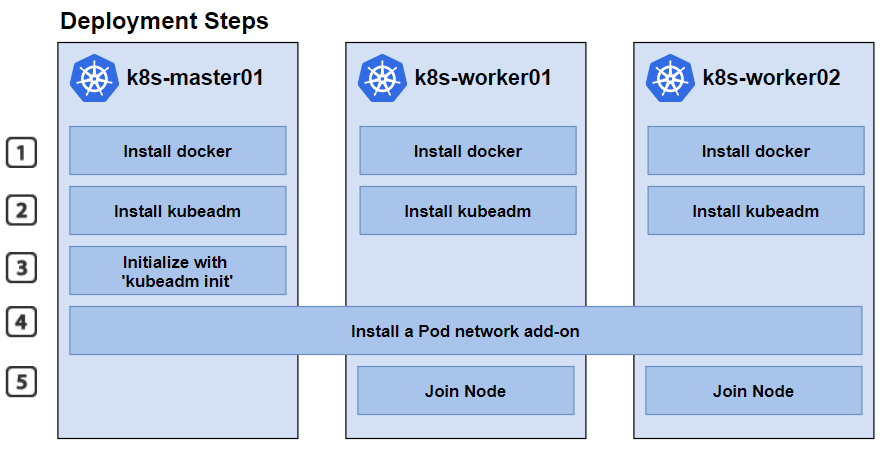Aim:
Publish website in new AKS (Azure Kubernetes Service) cluster, initially following the tutorial at https://docs.microsoft.com/en-us/azure/aks/tutorial-kubernetes-prepare-acr?tabs=azure-cli
Create the Azure Resources:
`This tutorial requires that you’re running the Azure CLI version 2.0.53 or later. Run az –version to find the version.
Use ‘az login’ to log into the Azure account:
az loginThe CLI will open your default browser, and load an Azure sign-in page, I have two-factor authentication enabled and need my phone to confirm access.
Create a new Resource Group:
az group create --name AKS4BIM02 --location northeuropeCreate an Azure Container Registry:
I will not use this initially, but I will create for future use.
az acr create --resource-group AKS4BIM02 --name acr4BIM --sku Basic
## List images in registry (None yet)
az acr repository list --name acr4BIM --output tableCreate the AKS cluster:
See options described at the following links:
- https://docs.microsoft.com/en-us/azure/aks/tutorial-kubernetes-deploy-cluster?tabs=azure-cli
- https://docs.microsoft.com/en-us/azure/aks/availability-zones
istacey@DUB004043:~$ az aks create \
> --resource-group AKS4BIM02 \
> --name AKS4BIM02 \
> --node-count 2 \
> --generate-ssh-keys \
> --zones 1 2Connect to the cluster:
If necessary install the Kubernetes CLI (az aks install-cli) and then connect:
$ az aks get-credentials --resource-group AKS4BIM02 --name AKS4BIM02
Merged "AKS4BIM02" as current context in /home/istacey/.kube/config
$ kubectl get nodes -o wide
NAME STATUS ROLES AGE VERSION INTERNAL-IP EXTERNAL-IP OS-IMAGE KERNEL-VERSION CONTAINER-RUNTIME
aks-nodepool1-88432225-vmss000000 Ready agent 7m22s v1.20.9 10.240.0.4 <none> Ubuntu 18.04.6 LTS 5.4.0-1059-azure containerd://1.4.9+azure
aks-nodepool1-88432225-vmss000001 Ready agent 7m17s v1.20.9 10.240.0.5 <none> Ubuntu 18.04.6 LTS 5.4.0-1059-azure containerd://1.4.9+azureCreate Storage Account and Azure File share
Following https://docs.microsoft.com/en-us/azure/aks/azure-files-volume
#Set variables:
AKS_PERS_STORAGE_ACCOUNT_NAME=istacestorageacct01
AKS_PERS_RESOURCE_GROUP=AKS4BIM02
AKS_PERS_LOCATION=northeurope
AKS_PERS_SHARE_NAME=aksshare4bim02
az storage account create -n $AKS_PERS_STORAGE_ACCOUNT_NAME -g $AKS_PERS_RESOURCE_GROUP -l $AKS_PERS_LOCATION --sku Standard_LRS
export AZURE_STORAGE_CONNECTION_STRING=$(az storage account show-connection-string -n $AKS_PERS_STORAGE_ACCOUNT_NAME -g $AKS_PERS_RESOURCE_GROUP -o tsv)
echo $AZURE_STORAGE_CONNECTION_STRING
az storage share create -n $AKS_PERS_SHARE_NAME --connection-string $AZURE_STORAGE_CONNECTION_STRING
STORAGE_KEY=$(az storage account keys list --resource-group $AKS_PERS_RESOURCE_GROUP --account-name $AKS_PERS_STORAGE_ACCOUNT_NAME --query "[0].value" -o tsv)
echo Storage account name: $AKS_PERS_STORAGE_ACCOUNT_NAME
echo $STORAGE_KEY
Create a Kubernetes secret:
kubectl create secret generic azure-secret --from-literal=azurestorageaccountname=$AKS_PERS_STORAGE_ACCOUNT_NAME --from-literal=azurestorageaccountkey=$STORAGE_KEYUpload index.html and images folder to file share via Azure Portal
index.html based on https://www.w3schools.com/howto/howto_css_coming_soon.asp and related to one of my favorite subjects Luton Town FC! 🙂

Create the Kubernetes Deployment
Create new namespace:
kubectl create ns isnginxCreate new deployment yaml manifest file:
$ vi nginx-deployment.yaml
$ cat nginx-deployment.yaml
apiVersion: apps/v1
kind: Deployment
metadata:
name: isnginx-deployment
namespace: isnginx
labels:
app: isnginx-deployment
spec:
replicas: 2
selector:
matchLabels:
app: isnginx-deployment
template:
metadata:
labels:
app: isnginx-deployment
spec:
containers:
- name: isnginx-deployment
image: nginx
volumeMounts:
- name: nginxtest01
mountPath: /usr/share/nginx/html
volumes:
- name: nginxtest01
azureFile:
secretName: azure-secret
shareName: aksshare4bim02
readOnly: falseCreate the deployment:
$ kubectl create -f nginx-deployment.yaml
deployment.apps/isnginx-deployment created
$ kubectl rollout status deployment isnginx-deployment -n isnginx
Waiting for deployment "isnginx-deployment" rollout to finish: 0 of 2 updated replicas are available...
$ kubectl -n isnginx describe pod isnginx-deployment-5ff78ff678-7dphq | tail -5
Type Reason Age From Message
---- ------ ---- ---- -------
Normal Scheduled 2m32s default-scheduler Successfully assigned isnginx/isnginx-deployment-5ff78ff678-7dphq to aks-nodepool1-88432225-vmss000000
Warning FailedMount 29s kubelet Unable to attach or mount volumes: unmounted volumes=[nginxtest01], unattached volumes=[default-token-lh6xf nginxtest01]: timed out waiting for the condition
Warning FailedMount 24s (x9 over 2m32s) kubelet MountVolume.SetUp failed for volume "aksshare4bim02" : Couldn't get secret isnginx/azure-secretMount failing as secret created in the default namespace.
Create a secret in the isnginx namespace:
kubectl -n isnginx create secret generic azure-secret --from-literal=azurestorageaccountname=$AKS_PERS_STORAGE_ACCOUNT_NAME --from-literal=azurestorageaccountkey=$STORAGE_KEY$ kubectl -n isnginx get secret
NAME TYPE DATA AGE
azure-secret Opaque 2 97m
default-token-lh6xf kubernetes.io/service-account-token 3 104mRemove the deployment and recreate:
$ kubectl delete -f nginx-deployment.yaml
deployment.apps "isnginx-deployment" deleted
$ kubectl create -f nginx-deployment.yaml
deployment.apps/isnginx-deployment created
$ kubectl rollout status deployment isnginx-deployment -n isnginx
Waiting for deployment "isnginx-deployment" rollout to finish: 0 of 2 updated replicas are available...
Waiting for deployment "isnginx-deployment" rollout to finish: 1 of 2 updated replicas are available...
deployment "isnginx-deployment" successfully rolled out$ kubectl -n isnginx get all
NAME READY STATUS RESTARTS AGE
pod/isnginx-deployment-6b8d9db99c-2kj5l 1/1 Running 0 80s
pod/isnginx-deployment-6b8d9db99c-w65gp 1/1 Running 0 80s
NAME READY UP-TO-DATE AVAILABLE AGE
deployment.apps/isnginx-deployment 2/2 2 2 80s
NAME DESIRED CURRENT READY AGE
replicaset.apps/isnginx-deployment-6b8d9db99c 2 2 2 80sCreate service / Expose deployment
And get external IP:
$ kubectl -n isnginx expose deployment isnginx-deployment --port=80 --type=LoadBalancer
service/isnginx-deployment exposed
$ kubectl -n isnginx get svc
NAME TYPE CLUSTER-IP EXTERNAL-IP PORT(S) AGE
isnginx-deployment LoadBalancer 10.0.110.58 20.93.54.110 80:30451/TCP 95mTest with curl and web browser:
$ curl http://20.93.54.110 | grep -i luton
% Total % Received % Xferd Average Speed Time Time Time Current
Dload Upload Total Spent Left Speed
100 2139 100 2139 0 0 44562 0 --:--:-- --:--:-- --:--:-- 45510
<p>Luton Town's New Stadium</p>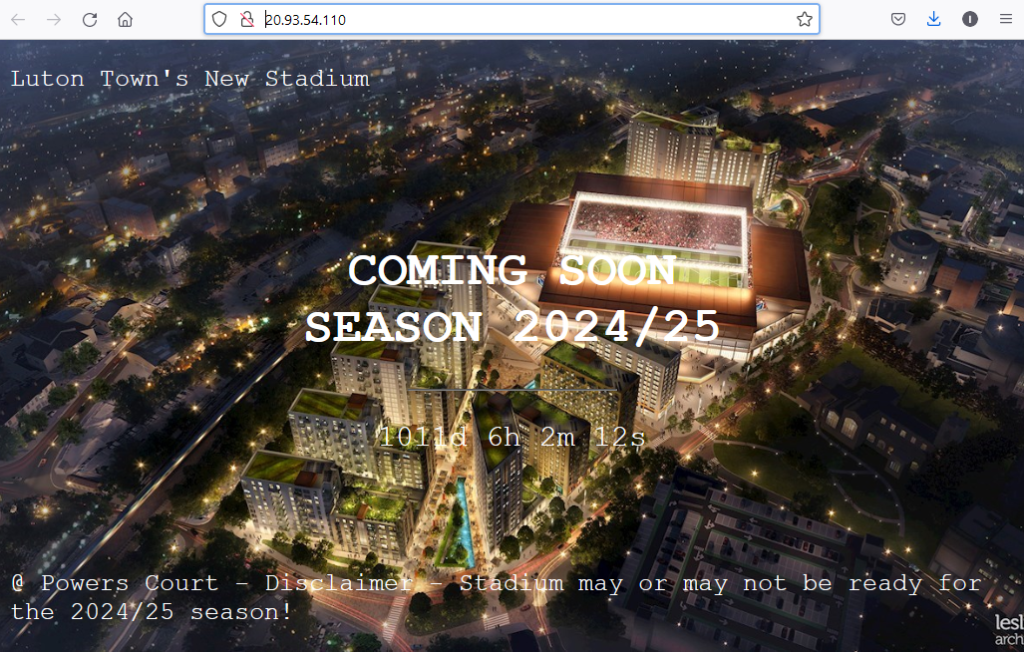
Create HTTPS ingress:
AIM: Create HTTPS ingress with signed certificate and redirect http requests to HTTPS. Following https://docs.microsoft.com/en-us/azure/aks/ingress-tls
Create Ingress controller:
kubectl apply -f https://raw.githubusercontent.com/kubernetes/ingress-nginx/controller-v1.0.4/deploy/static/provider/cloud/deploy.yaml$ kubectl -n ingress-nginx get all
NAME READY STATUS RESTARTS AGE
pod/ingress-nginx-admission-create-twnd7 0/1 Completed 0 8m3s
pod/ingress-nginx-admission-patch-vnsj4 0/1 Completed 1 8m3s
pod/ingress-nginx-controller-5d4b6f79c4-mknxc 1/1 Running 0 8m4s
NAME TYPE CLUSTER-IP EXTERNAL-IP PORT(S) AGE
service/ingress-nginx-controller LoadBalancer 10.0.77.11 20.105.96.112 80:31078/TCP,443:31889/TCP 8m4s
service/ingress-nginx-controller-admission ClusterIP 10.0.2.37 <none> 443/TCP 8m4s
NAME READY UP-TO-DATE AVAILABLE AGE
deployment.apps/ingress-nginx-controller 1/1 1 1 8m4s
NAME DESIRED CURRENT READY AGE
replicaset.apps/ingress-nginx-controller-5d4b6f79c4 1 1 1 8m4s
NAME COMPLETIONS DURATION AGE
job.batch/ingress-nginx-admission-create 1/1 1s 8m3s
job.batch/ingress-nginx-admission-patch 1/1 3s 8m3s
Add an A record to DNS zone
$ IP=20.105.96.112
$ DNSNAME="istac-aks-ingress"
$ PUBLICIPID=$(az network public-ip list --query "[?ipAddress!=null]|[?contains(ipAddress, '$IP')].[id]" --output tsv)
$ az network public-ip update --ids $PUBLICIPID --dns-name $DNSNAME
$ az network public-ip show --ids $PUBLICIPID --query "[dnsSettings.fqdn]" --output tsv
istac-aks-ingress.northeurope.cloudapp.azure.com
$ az network public-ip show --ids $PUBLICIPID --query "[dnsSettings.fqdn]" --output tsv | nslookup
Server: 89.101.160.4
Address: 89.101.160.4#53
Non-authoritative answer:
Name: istac-aks-ingress.northeurope.cloudapp.azure.com
Address: 20.105.96.112Install cert-manager with helm:
$ kubectl label namespace ingress-nginx cert-manager.io/disable-validation=true
namespace/ingress-nginx labeled
$ helm repo add jetstack https://charts.jetstack.io
"jetstack" has been added to your repositories
$ helm repo update
Hang tight while we grab the latest from your chart repositories...
...Successfully got an update from the "ingress-nginx" chart repository
...Successfully got an update from the "jetstack" chart repository
Update Complete. ⎈Happy Helming!⎈$ helm install cert-manager jetstack/cert-manager \
> --namespace ingress-nginx \
> --set installCRDs=true \
> --set nodeSelector."kubernetes\.io/os"=linux
NAME: cert-manager
LAST DEPLOYED: Mon Oct 25 10:56:51 2021
NAMESPACE: ingress-nginx
STATUS: deployed
REVISION: 1
TEST SUITE: None
NOTES:
cert-manager v1.5.4 has been deployed successfully!$ kubectl -n ingress-nginx get all
NAME READY STATUS RESTARTS AGE
pod/cert-manager-88ddc7f8d-ltz9z 1/1 Running 0 158m
pod/cert-manager-cainjector-748dc889c5-kcdx7 1/1 Running 0 158m
pod/cert-manager-webhook-55dfcc5474-tbrz2 1/1 Running 0 158m
pod/ingress-nginx-admission-create-twnd7 0/1 Completed 0 3h45m
pod/ingress-nginx-admission-patch-vnsj4 0/1 Completed 1 3h45m
pod/ingress-nginx-controller-5d4b6f79c4-mknxc 1/1 Running 0 3h45m
NAME TYPE CLUSTER-IP EXTERNAL-IP PORT(S) AGE
service/cert-manager ClusterIP 10.0.7.50 <none> 9402/TCP 158m
service/cert-manager-webhook ClusterIP 10.0.132.151 <none> 443/TCP 158m
service/ingress-nginx-controller LoadBalancer 10.0.77.11 20.105.96.112 80:31078/TCP,443:31889/TCP 3h45m
service/ingress-nginx-controller-admission ClusterIP 10.0.2.37 <none> 443/TCP 3h45m
NAME READY UP-TO-DATE AVAILABLE AGE
deployment.apps/cert-manager 1/1 1 1 158m
deployment.apps/cert-manager-cainjector 1/1 1 1 158m
deployment.apps/cert-manager-webhook 1/1 1 1 158m
deployment.apps/ingress-nginx-controller 1/1 1 1 3h45m
NAME DESIRED CURRENT READY AGE
replicaset.apps/cert-manager-88ddc7f8d 1 1 1 158m
replicaset.apps/cert-manager-cainjector-748dc889c5 1 1 1 158m
replicaset.apps/cert-manager-webhook-55dfcc5474 1 1 1 158m
replicaset.apps/ingress-nginx-controller-5d4b6f79c4 1 1 1 3h45m
NAME COMPLETIONS DURATION AGE
job.batch/ingress-nginx-admission-create 1/1 1s 3h45m
job.batch/ingress-nginx-admission-patch 1/1 3s 3h45mCreate a CA cluster issuer:
$ vi cluster-issuer.yaml
$ cat cluster-issuer.yaml
apiVersion: cert-manager.io/v1
kind: ClusterIssuer
metadata:
name: letsencrypt
spec:
acme:
server: https://acme-v02.api.letsencrypt.org/directory
email: ian@ianstacey.net
privateKeySecretRef:
name: letsencrypt
solvers:
- http01:
ingress:
class: nginx
podTemplate:
spec:
nodeSelector:
"kubernetes.io/os": linux
$ kubectl apply -f cluster-issuer.yaml
clusterissuer.cert-manager.io/letsencrypt createdCreate an ingress route:
$ cat http7-ingress.yaml
apiVersion: networking.k8s.io/v1
kind: Ingress
metadata:
name: powercourt-ingress
namespace: isnginx
annotations:
kubernetes.io/ingress.class: nginx
nginx.ingress.kubernetes.io/use-regex: "true"
nginx.ingress.kubernetes.io/ssl-redirect: "true"
nginx.ingress.kubernetes.io/use-regex: "true"
nginx.ingress.kubernetes.io/rewrite-target: /$2
cert-manager.io/cluster-issuer: letsencrypt
spec:
tls:
- hosts:
- istac-aks-ingress.northeurope.cloudapp.azure.com
secretName: tls-secret
defaultBackend:
service:
name: isnginx-clusterip
port:
number: 80
$ kubectl apply -f http7-ingress.yaml
ingress.networking.k8s.io/powercourt-ingress configuredCheck resources:
$ kubectl -n isnginx describe ingress powercourt-ingress
Name: powercourt-ingress
Namespace: isnginx
Address: 20.105.96.112
Default backend: isnginx-clusterip:80 (10.244.0.7:80,10.244.1.4:80)
TLS:
tls-secret terminates istac-aks-ingress.northeurope.cloudapp.azure.com
Rules:
Host Path Backends
---- ---- --------
* * isnginx-clusterip:80 (10.244.0.7:80,10.244.1.4:80)
Annotations: cert-manager.io/cluster-issuer: letsencrypt
kubernetes.io/ingress.class: nginx
nginx.ingress.kubernetes.io/rewrite-target: /$2
nginx.ingress.kubernetes.io/use-regex: true
Events:
Type Reason Age From Message
---- ------ ---- ---- -------
Normal Sync 13m (x10 over 3h51m) nginx-ingress-controller Scheduled for sync
Normal UpdateCertificate 13m (x3 over 25m) cert-manager Successfully updated Certificate "tls-secret"
$ kubectl get certificate tls-secret --namespace isnginx
NAME READY SECRET AGE
tls-secret True tls-secret 144m
$ kubectl get certificate tls-secret --namespace isnginx -o yaml
apiVersion: cert-manager.io/v1
kind: Certificate
metadata:
creationTimestamp: "2021-10-25T10:17:02Z"
generation: 4
name: tls-secret
namespace: isnginx
ownerReferences:
- apiVersion: networking.k8s.io/v1
blockOwnerDeletion: true
controller: true
kind: Ingress
name: powercourt-ingress
uid: e93a8939-1ed6-444b-b2db-b26aedf01dd8
resourceVersion: "122626"
uid: 79631ea4-541b-4251-9c7b-ad5294e6bbc0
spec:
dnsNames:
- istac-aks-ingress.northeurope.cloudapp.azure.com
issuerRef:
group: cert-manager.io
kind: ClusterIssuer
name: letsencrypt
secretName: tls-secret
usages:
- digital signature
- key encipherment
status:
conditions:
- lastTransitionTime: "2021-10-25T12:28:08Z"
message: Certificate is up to date and has not expired
observedGeneration: 4
reason: Ready
status: "True"
type: Ready
notAfter: "2022-01-23T11:28:06Z"
notBefore: "2021-10-25T11:28:07Z"
renewalTime: "2021-12-24T11:28:06Z"
revision: 4Test:
http requests to http://istac-aks-ingress.northeurope.cloudapp.azure.com are successfully redirected to https:
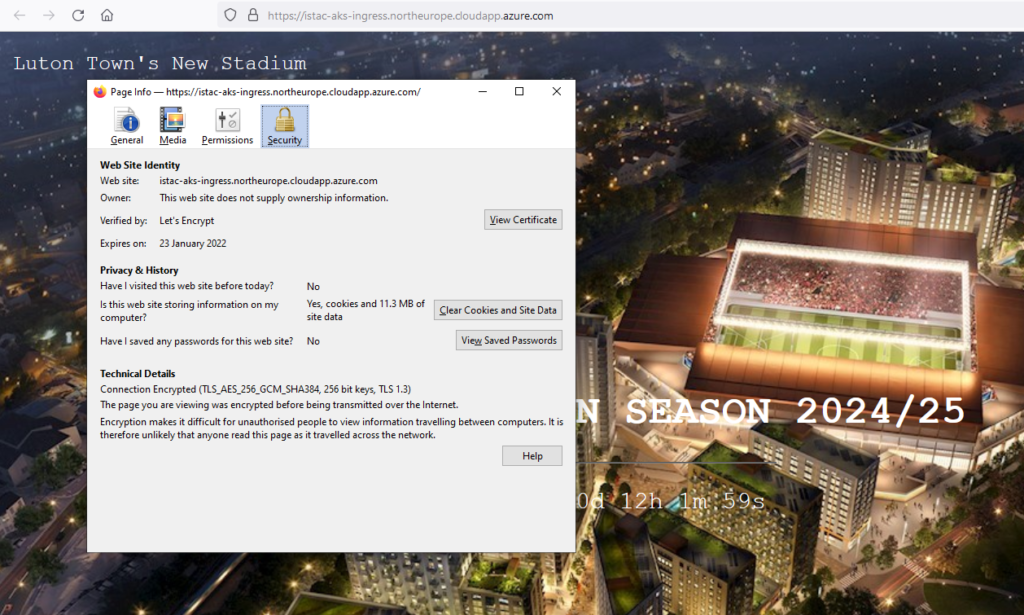
The finished architecture:
